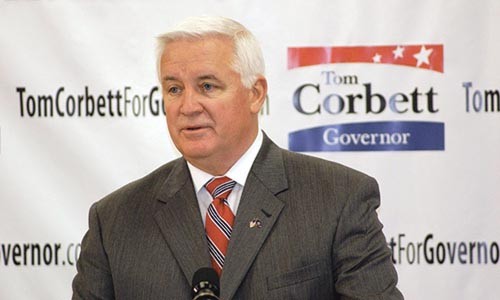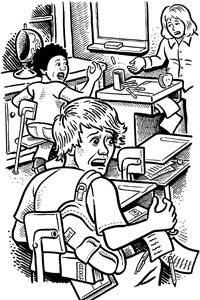When she entered Indiana University of Pennsylvania last fall, 19-year-old freshman Jess Bruckhart did what she was supposed to do: Study and get good grades.
Even before she entered IUP, Bruckhart was given a grant as a reward for getting good grades. It was a boon to Bruckhart, of Johnstown, who is majoring in regional planning: Like many students, "I depend on my financial aid," she says.
But on March 8, Gov. Tom Corbett delivered his budget address ... and the news that he was balancing the budget largely with drastic cuts in education. His budget proposal envisions a whopping 50 percent cut to the Pennsylvania State System of Higher Education (PASSHE), a 14-school network of state-funded schools that includes IUP, California University, Clarion and Edinboro. State-assisted schools like Penn State and the University of Pittsburgh, which receive state funding while operating independently, would also see their allocations cut in half.
Corbett has also suggested that those schools may be getting even less money when the budget crisis passes -- as more state money goes to grant programs that could be used at private schools, too.
Such proposals have sent educators and students scrambling to figure out how deeply the cuts will affect them. For some, like Bruckhart, the math is simple:
"If they cut my funding, there's no way I'd be able to pay for [IUP]."
In his budget address, Corbett called on college administrators to "consider sacrifice. I ask nothing more of our best-educated people than to face up to a hard economic reality: The system in which you have flourished is in trouble."
Educators say they've been facing that reality for some time.
Kenn Marshall, spokesman for the PASSHE, says the state-university system was making sacrifices before Corbett took office.
"We have already been engaged in cutting costs," says Marshall. "We've cut $220 million from our budget [in the past decade] through joint purchasing, energy-conservation projects and offering retirement incentives last year to 250 employees at a savings of $8 million.
"We have raised tuition in four of the last five years, but all of those increases have been below the rate of inflation. It keeps getting harder to keep costs down for students, but that is our goal."
At one time, Marshall says, student tuitions paid only one-third of the cost of attending a PASSHE school; state funding paid for the remaining two-thirds. "Today, [that ratio] has completely flip-flopped."
Still, Marshall adds, "Other states have seen significantly higher cuts, so from that standpoint we've been fortunate. ...We understand that the administration has been facing enormous challenges and they must deal with the deficit. Hopefully as the economy recovers, things will improve."
For now, though, school administrators are expressing grave concern.
In an email to students last week, IUP Interim President David Werner told students, "[W]e had anticipated a decline in funding and had prepared various scenarios to deal with it. However, nobody expected a cut this big."
California University of Pennsylvania President Angelo Armenti Jr. struck a similar tone in a March 9 statement. He too, called the budget cuts "unprecedented," and said that the school's appropriations have been "steadily declining," by an average of 1.4 percent per year since 1984.
"The governor's budget, however, sharply accelerates this trend," wrote Armenti. "Under his plan, the portion of Cal U's budget supported by state appropriations would decline from about 30 percent to just 15 percent in the coming year."
The University of Pittsburgh and Penn State also face challenges. Under Corbett's proposal, Penn State would receive a reduction from $304 million to $152 million next year. PSU President Graham Spanier has warned the cuts may require the closure of branch campuses. Penn State has several regional branch campuses including sites in Beaver County, McKeesport, New Kensington and Fayette County.
Corbett has fired back at some school administrators. At a March 17 press conference in Scranton, Corbett noted that Penn State received some $3.6 billion in the past decade. During "[t]he same period of time, when they got the money they wanted, they increased tuition by 110 percent," the Wilkes-Barre Times Leader quoted him saying. "Now who's putting it on the backs of the students?"
Corbett had made a similar argument during his budget address -- coupling it with a plan to "re-think state spending on higher education."
"Despite state subsidies over the past decades, tuition has continued to increase," Corbett said. "If the intent was to keep tuition rates down, it failed. We need to find a new model. When it comes to higher education ... the dollars should follow the student."
Based on these and other signals, some educators are expecting -- and looking forward to -- a time when the state offsets reductions to state-related schools by increasing aid to students. That could happen in the form of increasing grants to students from the Pennsylvania Higher Education Assistance Agency (PHEAA), whose financial aid can offset the cost at private and public college alike.
"The positive we see here is that the governor wants to direct more public money directly toward students ... and we think that is a very good policy," says Don Francis, who heads the Association of Independent Colleges and Universities of Pennsylvania.
Francis has reason to see the upside of such a shift: His organization represents the state's 87 private colleges, including such area schools as Duquesne University, LaRoche College and Allegheny College. Increased PHEAA funding could benefit them in a way direct subsidies to other schools would not. "If you've got a student in Greene County who wants to stay close to home and go to school, Waynesburg College may be the best place for him," Francis says. "But under the current system, maybe he doesn't have that option due to financial issues."
For now, though, Corbett's budget is hurting private schools too: It also envisions a 50 percent cut in PHEAA grants for the coming year.
For state-supported schools, it's a double-whammy: Both they and their students will have a hard time paying the bills. Even for private colleges the financial-aid cuts will be tough, Francis acknowledges. But he adds, "As the economy improves, our hope would be that more money is made available for this purpose."
In the meantime, students say they are getting a firsthand lesson in political science.
"He promised to not raise taxes. He has to do what he has to do to fulfill his campaign promises," says Natasha Terensky, a first-year student studying international business at Penn State Beaver, in Monaca. "He knows the majority of [students] don't vote, so he doesn't care if he screws us over."
In fact, a March 19 classroom walkout and protest advertised on Facebook at IUP didn't draw one student. (As this issue went to press, organizers were taking another stab at a rally March 22.) A similar rally the same day at Cal U brought out 14 students.
One of them, Crista Colantoni, came to Cal U from Nebraska to pursue her masters' degree in education -- "specifically for the level of education that Pennsylvania is known for. But it seems the state government is no longer willing to support that."
If Corbett's proposed budget passes, Colantoni says, she will leave Pennsylvania after completing her degree. "I came here for academic excellence, and [with these cuts] the governor seems to be supporting academic mediocrity."
Bill Hendricks, a Cal U English professor, says he is troubled by the state-legislative view of education. He says the cuts "seem to express clearly that public education should be a private benefit, not a social good."
Marshall, of PASSHE, notes that the governor's original budget proposal is "just the first step of a very long process." In fact even some state Republicans have promised to restore at least some of the funding. The state has until June 30 to complete the budget, and the legislature has been holding hearings on it.
Still, at IUP and schools across the state, students like Bruckhart are starting to weigh their educational options under the Corbett regime. To reduce costs, she can move back to Johnstown, live at home and go to Pitt's satellite campus there. But that would mean abandoning her major in regional planning: Pitt-Johnstown doesn't offer that program.
"It's a scary time to go to college," Bruckhart says.
Reporting for this story was contributed by Alyssa Choiniere at Indiana University of Pennsylvania, Michael Puchany at California University and Dana Sklack at Penn State Beaver.
















